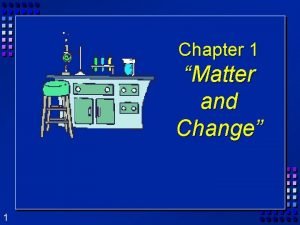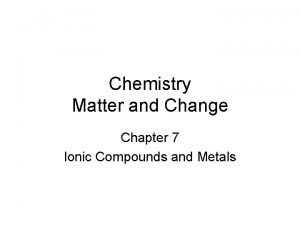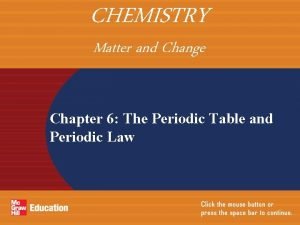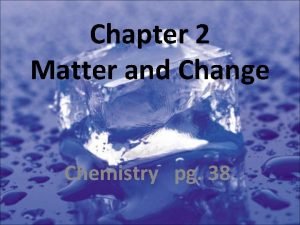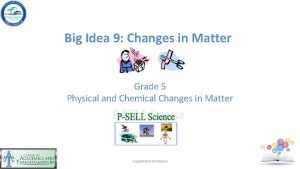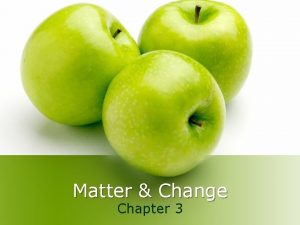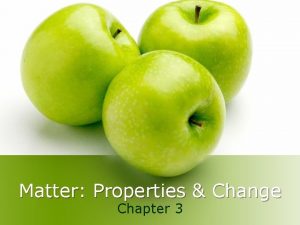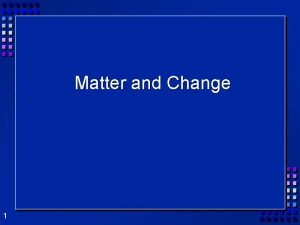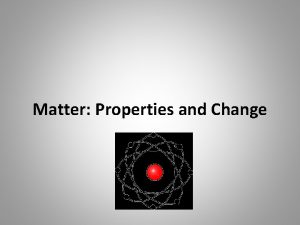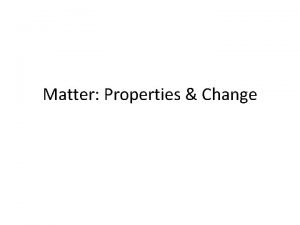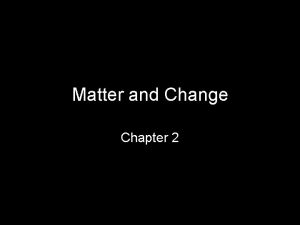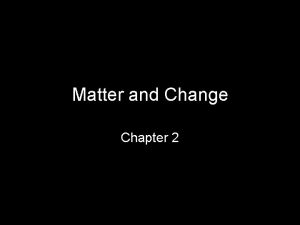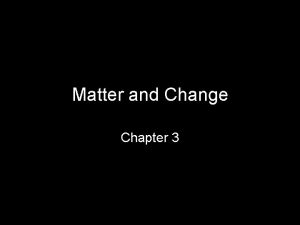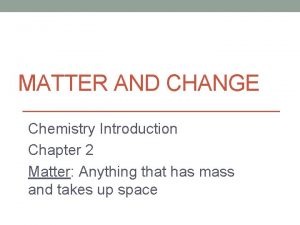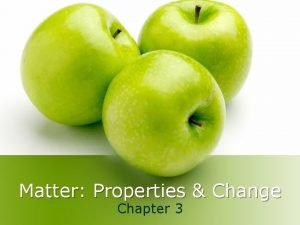Chapter 2 Matter and Change 1 Matter Matter































- Slides: 31

Chapter 2 “Matter and Change” 1

Matter Ø Matter is anything that: a) has mass, and b) takes up space Ø Mass = a measure of the amount of “stuff” (or material) the object contains (don’t confuse this with weight, a measure of gravity) Ø Volume = a measure of the space occupied by the object 2

Describing Matter Ø Properties used to describe matter can be classified as: 1) Extensive – depends on the amount of matter in the sample - Mass, volume, calories are examples 2) Intensive – depends on the type of matter, not the amount present - Hardness, Density, Boiling Point 3

Properties are… Ø Words that describe matter (adjectives) Ø Physical Properties- a property that can be observed and measured without changing the material’s composition. Ø Examples- color, hardness, m. p. , b. p. Ø Chemical Properties- a property that can only be observed by changing the composition of the material. Ø Examples- ability to burn, decompose, ferment, react with, etc. 4

States of matter 1) Solid- matter that can not flow (definite shape) and has definite volume. 2) Liquid- definite volume but takes the shape of its container (flows). 3) Gas- a substance without definite volume or shape and can flow. – Vapor- a substance that is currently a gas, but normally is a liquid or solid at room temperature. (Which is correct: “water gas”, or “water vapor”? ) 5

States of Matter Definite Volume? Shape? Solid Liquid Gas 6 YES NO Result of a Temperature Will it Compress? Increase? YES Small Expans. NO NO Large Expans. YES

Three Main Phases – page 41 7

Condense Freeze Evaporate Melt Solid 8 Liquid Gas

Copper Phases - Solid 9

Copper Phases - Liquid 10

Copper Phases – Vapor (gas) 11

Physical vs. Chemical Change Ø Physical change will change the visible appearance, without changing the composition of the material. – Boil, melt, cut, bend, split, crack – Is boiled water still water? Ø Can be reversible, or irreversible Ø Chemical change - a change where a new form of matter is formed. – Rust, burn, decompose, ferment 12

Is it Physical or Chemical? Change Melting cheese Burning wood Milk souring (Do all students relate to this? ) Wadding up paper Bicycle rusting 13 Physical Chemical

Mixtures are a physical blend of at least two substances; have variable composition. They can be either: 1) Heterogeneous – the mixture is not uniform in composition • Chocolate chip cookie, gravel, soil. 2) Homogeneous - same composition throughout; called “solutions” • Kool-aid, air, salt water Ø Every part keeps it’s own properties. Ø 14

Phase? Ø The term “phase” is used to describe any part of a sample with uniform composition of properties. Ø A homogeneous mixture consists of a single phase Ø A heterogeneous mixture consists of two or more phases. Ø Note Figure 2. 6, page 45 15

Separating Mixtures Ø Some can be separated easily by physical means: rocks and marbles, iron filings and sulfur (use magnet) Ø Differences in physical properties can be used to separate mixtures. Ø Filtration - separates a solid from the liquid in a heterogeneous mixture (by size) – Figure 2. 7, page 46 16

Separation of a Mixture Components of dyes such as ink may be separated by paper chromatography. 17

Separation of a Mixture Distillation: takes advantage of different boiling points. Na. Cl boils at 1415 o. C 18

Substances are either: a) elements, or b) compounds 19

Substances: element or compound Elements- simplest kind of matter – cannot be broken down any simpler and still have properties of that element! – all one kind of atom. Ø Compounds are substances that can be broken down only by chemical methods – when broken down, the pieces have completely different properties than the original compound. – made of two or more atoms, chemically combined (not just a physical blend!) Ø 20

Compound vs. Mixture Compound 21 Mixture Made of one kind of material Made of more than one kind of material Made by a chemical change Made by a physical change Definite composition Variable composition

Which is it? Mixture Element Compound 22

Elements vs. Compounds Ø Compounds can be broken down into simpler substances by chemical means, but elements cannot. Ø A “chemical change” is a change that produces matter with a different composition than the original matter. 23

Chemical Change A change in which one or more substances are converted into different substances. Heat and light are often evidence of a chemical change. 24

Properties of Compounds Ø Quite different properties than their component elements. Ø Due to a CHEMICAL CHANGE, the resulting compound has new and different properties: • Table sugar – carbon, hydrogen, oxygen • Sodium chloride – sodium, chlorine • Water – hydrogen, oxygen 25

Chemical Changes Ø The ability of a substance to undergo a specific chemical change is called a chemical property. • iron plus oxygen forms rust, so the ability to rust is a chemical property of iron Ø During a chemical change (also called chemical reaction), the composition of matter always changes. 26

Chemical Reactions are… Ø When 27 one or more substances are changed into new substances. Ø Reactants- the stuff you start with Ø Products- what you make Ø The products will have NEW PROPERTIES different from the reactants you started with Ø Arrow points from the reactants to the new products

Recognizing Chemical Changes 1) Energy is absorbed or released (temperature changes hotter or colder) 2) Color changes 3) Gas production (bubbling, fizzing, or odor change; smoke) 4) formation of a precipitate - a solid that separates from solution (won’t dissolve) 5) Irreversibility - not easily reversed But, there are examples of these that are not chemical – boiling water bubbles, etc. 28

Conservation of Mass Ø During any chemical reaction, the mass of the products is always equal to the mass of the reactants. Ø All the mass can be accounted for: – Burning of wood results in products that appear to have less mass as ashes; where is the rest? ØLaw 29 of conservation of mass

- Page 55 43. 43 g Original mass = 43. 43 g Final mass reactants 30 = product

31
 Chemistry matter and change chapter 7
Chemistry matter and change chapter 7 Chapter 10 study guide the mole
Chapter 10 study guide the mole Chapter 1 review matter and change
Chapter 1 review matter and change 1s 22 s22 p63 s23 p64 s2
1s 22 s22 p63 s23 p64 s2 Chemistry matter and change chapter 6
Chemistry matter and change chapter 6 Chemistry matter and change chapter 10 the mole answer key
Chemistry matter and change chapter 10 the mole answer key 2 matter and change answer key
2 matter and change answer key Chapter 1 matter and change worksheet answers
Chapter 1 matter and change worksheet answers Chapter 2 matter section 1 classifying matter answer key
Chapter 2 matter section 1 classifying matter answer key Physical change
Physical change Absolute change and relative change formula
Absolute change and relative change formula Whats the difference between chemical and physical change
Whats the difference between chemical and physical change Change in supply and change in quantity supplied
Change in supply and change in quantity supplied Physical change
Physical change Rocks change due to temperature and pressure change
Rocks change due to temperature and pressure change Whats the difference between chemical and physical change
Whats the difference between chemical and physical change First order second order change
First order second order change Changes in matter grade 5
Changes in matter grade 5 Unit 2 matter and change
Unit 2 matter and change Grey matter of nervous system
Grey matter of nervous system Optic tract
Optic tract Gray matter and white matter
Gray matter and white matter Telecephalon
Telecephalon Is cutting paper a physical change
Is cutting paper a physical change Integer
Integer Input and output market
Input and output market Enagic founder
Enagic founder Proactive and reactive change
Proactive and reactive change Spare change physical versus chemical change
Spare change physical versus chemical change How does a physical change differ from a chemical change? *
How does a physical change differ from a chemical change? * Chemical changes in baking
Chemical changes in baking Is chopping wood physical or chemical
Is chopping wood physical or chemical


